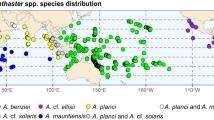Abstract.
Previous molecular phylogenetic analyses have shown that five tropical lucinid species living in or near Thalassia testudinum seagrass beds are colonized by the same bacterial symbiont species. In addition, a new lucinid species belonging to the genus Anodontia, which inhabits reducing sediment found near seagrass beds and in mangrove swamps, has been included in the present study. Endosymbiosis in Anodontia alba was examined according to symbiont phylogenetic and gill ultrastructural analysis. Phylogenetic analysis showed that partial 16S rDNA sequences of A. alba– and Codakia orbicularis–symbionts were 100% identical at all nucleotide positions determined, suggesting that A. alba also harbors the same symbiont species as C. orbicularis (and, consequently, as C. orbiculata, C. pectinella, Linga pensylvanica and Divaricella quadrisulcata). Based on light and electron microscopy, the cellular organization of the gill filament appeared similar to those already described in other lucinids. The most distinctive feature is the lack of "granule cells" in the lateral zone of A. alba gill filaments. In order to confirm the single-species hypothesis, purified fractions of gill bacterial symbionts obtained from the gills of each of the six tropical lucinids cited above were used to infect aposymbiotic juveniles of C. orbicularis. In each case, aposymbiotic juvenile batches were successfully infected by the gill-endosymbiont fractions, whereas, during the experiments, juveniles from the negative control were still uninfected. These experimental data confirm the phylogenetic data and also demonstrate that chemoautotrophic bacterial endosymbionts from their host cells can colonize aposymbiotic juveniles. The conclusion also follows that intracellular gill-endosymbionts still have the capacity to recognize and colonize new host generations. Lucinids provide a unique model for the study of sulfide-oxidizing symbiosis, even if symbionts remain unculturable.
Similar content being viewed by others
Author information
Authors and Affiliations
Additional information
Electronic Publication
Rights and permissions
About this article
Cite this article
Gros, .O., Liberge, .M. & Felbeck, .H. Interspecific infection of aposymbiotic juveniles of Codakia orbicularis by various tropical lucinid gill-endosymbionts. Marine Biology 142, 57–66 (2003). https://doi.org/10.1007/s00227-002-0921-7
Received:
Accepted:
Issue Date:
DOI: https://doi.org/10.1007/s00227-002-0921-7




